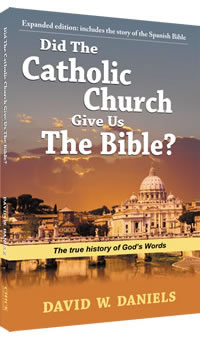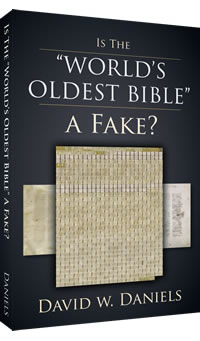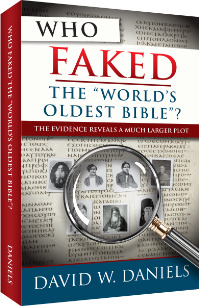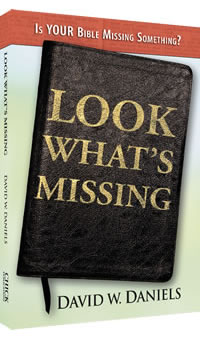Why was the Apocrypha in the Original King James Bible?

By David W. Daniels
Some are wondering: What are the Apocryphal books? The short answer is they are folktales that the popes needed in the Bible to justify some of their pagan doctrines not supported by Scripture.
During the KJV translation process, Roman sympathizers in the Anglican church pressured the translators to include the stories. The translators severely objected but compromised by inserting them in a separate section between the Testaments, instead of sprinkling them throughout the Old Testament as was customary in Roman Catholic Bibles.
The translators also insisted on giving their project overseers seven objections to including the Apocrypha at all:
1. Not one of them is in the Hebrew language, which was alone used by the inspired historians and poets of the Old Testament.
2. Not one of the writers lays any claim to inspiration.
3. These books were never acknowledged as sacred Scriptures by the Jewish Church and, therefore, were never sanctioned by our Lord.
4. They were not allowed a place among the sacred books, during the first four centuries of the Christian Church.
5. They contain statements which contradict the canonical Scriptures as well as other apocryphal writings. For example, in the two Books of Maccabees, Antiochus Epiphanes is made to die three different deaths in as many different places.
6. It supports unbiblical, Catholic doctrines that disagree with the Bible, such as purgatory, prayers for the dead (2 Maccabees) and sinless perfection. It also promotes works-based salvation and contradicts biblical teaching that clearly states salvation is by grace alone, through faith alone in Christ alone.
7. It teaches immoral practices, such as lying, suicide, assassination, and magical incantation.
The Apocrypha is filled with concepts that directly contradict the message of the gospel and the sufficiency of Christ’s atoning work. By including these doctrines, the Apocrypha encourages practices and beliefs that detract from a biblical understanding of salvation.
When they translated the books, the KJV translators were careful to clearly separate the Apocrypha from the text of the Bible. They put it in a separate section between the Old and New Testaments and clearly labeled each page, “Apocrypha.” The last page of II Maccabees in the 1611 King James reads, “End of Apocrypha.” Then it returns to God’s inspired words in Matthew.
As the Bible went into multiple printings, the Apocrypha was dropped as early as 1616! There wasn’t any Apocrypha in many printings of the Bible, dated 1616, ‘18, ‘20, ‘22, ‘26, ‘27, ‘29 and ‘30.1
One historian wrote: “The aversion had so prevailed that the Apocrypha began to be dropped … indeed, as early as 1633, such Bibles [without Apocrypha] were becoming fashionable....”2
I agree with the King James translators. The Apocrypha does not belong in the Bible. The Apocrypha is a collection of folk tales and legends, not inspired Scripture. These stories cannot be trusted as divinely inspired, nor do they carry the authority of the 66 books of the canonical Bible. They should not be relied upon as the authoritative Word of God.
We can be confident that we have all of God’s words to us in the 66 Books of our King James Bible, without the Apocrypha.
1 See The Oxford Annotated Apocrypha, Expanded Edition by Bruce Metzger (1965, 1977), p. xviii.
2 Our English Bible: Its Translations and Translators, by John Stoughton (London: William Rider and Son, pub. 1882-1885), p. 271. Available at archive.org.
- See more articles on related topics:
- Bible Versions
- False Religions
- King James Bible
- Apocrypha
Other Articles from May/June 2025:
More on Bible Versions:
Products of Interest:
-

Answers to Your Bible Version Questions
224 pages
David W. Daniels answers difficult questions about the KJV. Learn how to defend the KJV and why you can trust it. -

Did the Catholic Church Give Us the Bible?
208 pages
The Bible has two histories. One is of God preserving His words through His people. The other is of the devil using Roman Catholic "scholars" to pervert God’s words and give us corrupt modern Bibles. -

Is The "World's Oldest Bible" a Fake?
352 pages
Here is proof that the Sinaiticus, a supposedly ancient Bible text on which modern Bibles are based, is actually a 19th-century fake. -

Who Faked the "World’s Oldest Bible"?
448 pages
The crime is fraud, and you’re the detective! If the devil has cooked up a plot against your Bible, would you want to know it? In this book, you'll discover the evidence that reveals a much larger plot. -

Look What's Missing!
256 pages
For years, publishers have been removing words, and even whole verses, from modern Bibles. What's missing from your Bible? Take a look!



